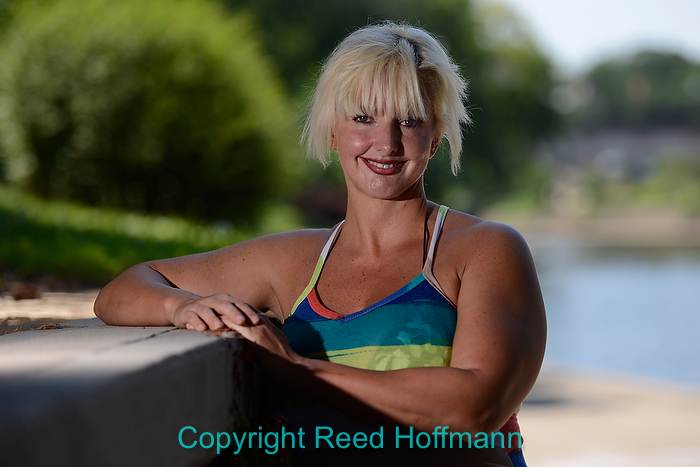While most of what I do these days is teaching, I still shoot some assignment work around Kansas City. Last week I had a job for the New York Daily News, and thought I’d write about what went into that.
The News wanted me to work with a reporter on a follow-up story about a woman who was asked to leave a waterpark in early July. The staff there said her outfit was too revealing. You can look at the photos of Madelyn and make your own decision. She felt, and I tend to agree with her, that they were responding to an older, full-bodied woman in a bikini, not what was showing. Anyway, our job was to track her down and do a story on the aftermath. She agreed to meet us at a library near the Country Club Plaza (south of downtown Kansas City) for an interview and photos.
When I get an assignment, I have two goals. First, to come away with a solid set of photos that make the client happy. And second, to see if I can find a way to shoot at least some of the pictures in a unique way. Since this was an interview, that meant I’d be doing pictures of her as she spoke and then some portraits afterwards.
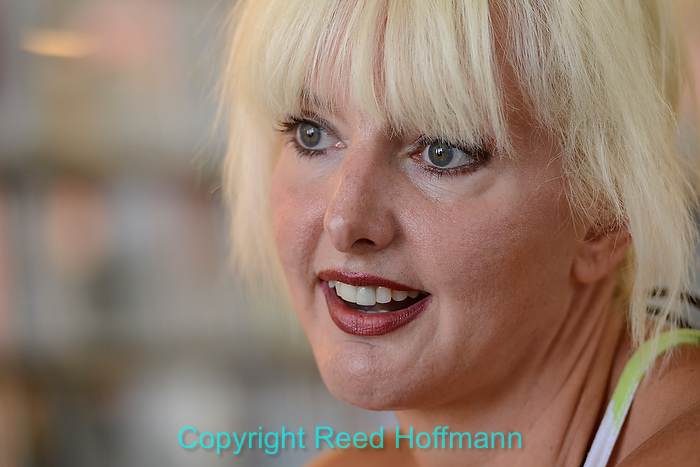
For the interview shots, it was important to make photos that clearly showed what Madelyn looked like, with nice light, good color and a clean background. Nikon D600 set to white balance of PRESET1 and ISO of 640, shutter speed of 1/160 at f/4, with exposure compensation at -0.3, 70-200mm lens at 200mm. Photo copyright Reed Hoffmann.
When possible, I like go early and do a little scouting. Hoping that Madelyn would agree to go outside for the portraits, I walked around the library and found some nice spots nearby, on a walkway along Brush Creek. There were a few areas of shade, which would be important because this was just after noon on a sunny, hot day. Those shady areas would provide good, soft light to photograph Madelyn. And they’d also give me a chance to do something special. More on that later.
We started with the interview in the library. Since it really didn’t matter where that took place, I suggested a spot that would work well for the photos. That meant I wanted good light (near some large windows) and a clean, non-distracting background (bookshelves). Since there were also fluorescent lights, I did a White Balance Preset (custom white balance) so the color would be right. If I didn’t take that step, then I might have to spend time afterwards correcting the color.
Next, I chose to use a telephoto lens (70-200mm) for the talking shots, to make sure the background stayed out of focus. I set the aperture for f/4, then settled on 640 ISO because that let me shoot at around 1/200 of a second, fast enough for a talking head but not such a high ISO that noise would be an issue.
She agreed to do the other photos outside, so once the interview was done we walked down to the creek. I knew I wanted to use those shady areas not just for their soft light, but because I could use something Nikon calls “Auto FP” flash. Other manufacturers might call it “high speed sync,” but it comes down to the same thing – it allows you to shoot at a higher shutter speed than flash sync (which is usually 1/200 or 1/250 second). Going above that lets you create some unusual photos because you can use wider apertures, to create dreamy out-of-focus backgrounds.

First I did some test shots to get the background the way I wanted it to look. Nikon D600 set to white balance of FLASH and ISO of 100, shutter speed of 1/4000 at f/2, with exposure compensation at -0.3, 85mm lens. Photo copyright Reed Hoffmann.
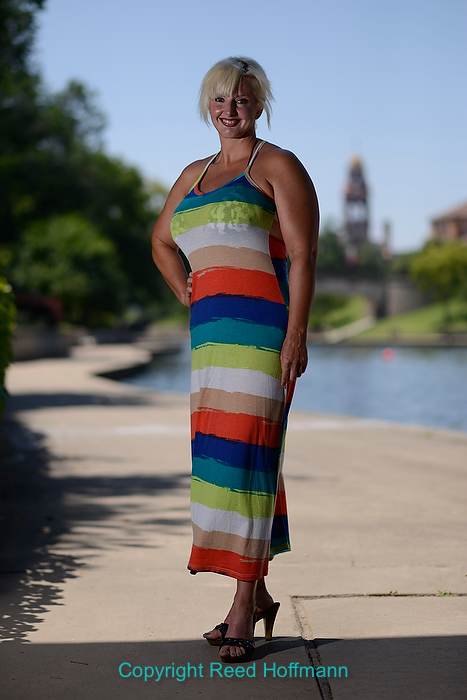
With the background exposure right, I just needed to turn on the flash. Nikon D600 set to white balance of FLASH and ISO of 100, shutter speed of 1/4000 at f/2, with exposure compensation at -0.3, 85mm lens. Photo copyright Reed Hoffmann.
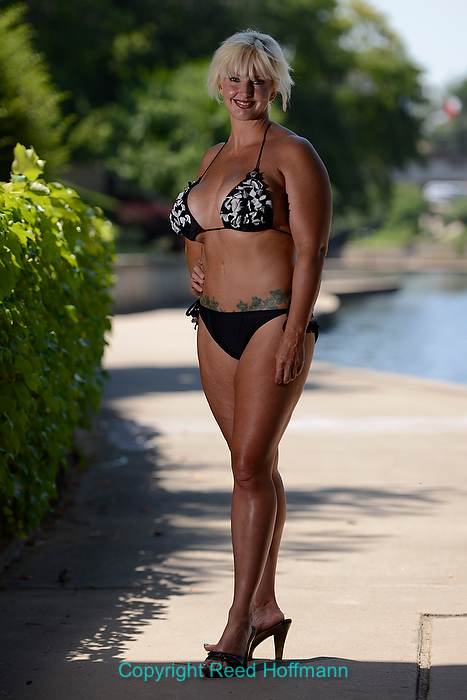
We had to see the bikini that created all the fuss. Nikon D600 set to white balance of FLASH and ISO of 100, shutter speed of 1/4000 at f/2, with exposure compensation at -0.3, 85mm lens. Photo copyright Reed Hoffmann.
When doing this, the first thing I want to do is figure out what my base exposure should be. I begin by setting the ISO low, 100 this time, because I want to use a wide aperture, which means a high shutter speed. Then, with the camera in Manual exposure mode, I find an exposure where the background looks good, preferably a little on the dark side. In this case that was at 1/4000 second with the 85mm lens at f/2.0.
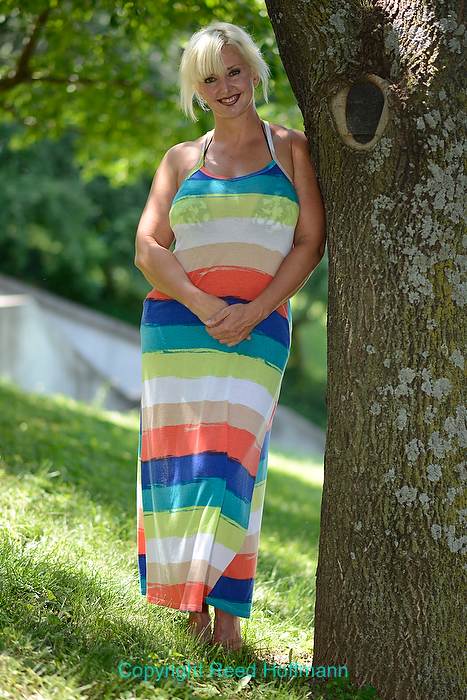
For the last shot, I used fill flash balanced with sunlight from above. Nikon D600 set to white balance of FLASH and ISO of 100, shutter speed of 1/400 at f/2, with exposure compensation at -0.3, 85mm lens. Photo copyright Reed Hoffmann.
Next step is to get the flash near her, since using Auto FP means the flash will be “pulsing” light, so it won’t have the power of a single burst. Setting my Nikon SB-910 on the wall to the side of Madelyn, I let the pop-up flash on my Nikon D600 fire it using Commander Mode. Having the sensor on the side of the flash pointed towards me made sure it could see the flash from my camera. Otherwise it wouldn’t fire.
The last shoot we did was under a tree with some dappled sunlight coming in from above, which highlighted her hair and shoulders. And I used flash for this shot too. Direct flash is normally a no-no, but using it for fill can work very well. The secret is to power it down some. So with the SB-910 mounted on the camera, I used the dial on the back of it to set a minus-1.0 exposure (just for the flash, not the camera). And that added a nice touch of light to her face and catchlights in her eyes.
After that it was a quick drive back home to download, select, crop, caption and transmit the photos. While we have the ability to “touch” every photo now, whenever possible I try to shoot them the way I want them. In this case, that meant I could deliver the pictures faster. The interview started at 1pm, and the editor had the photos around 3:30. Better yet, they were happy with the work, and the story and photos led their website the next day.
I’ve always enjoyed doing assignments. That was one of the reasons I stayed in newspapers for so long. The opportunity to get out and meet people, hear their stories and try to make meaningful photos is a challenge I still look forward to. And these days, with all the new tools available to us as photographers, that challenge is even more fun. With luck I’ll be doing assignments for many more years to come.

